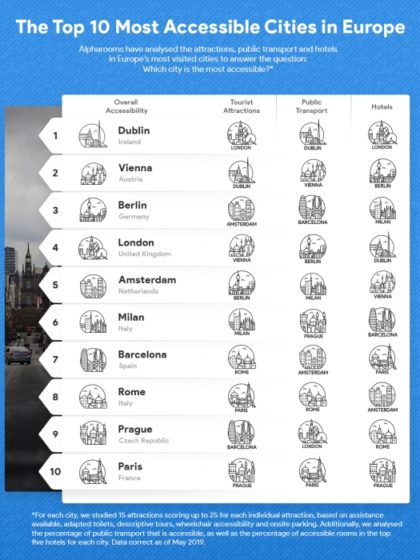The Most Accessible Cities For Tourists Revealed
While many of us would love to travel the world, it’s not always easy for those with limited mobility and who rely on assistance from others.
Accessible travel is a hotly debated subject. However, many European cities are yet to transform their destination and make it accessible to all.
With that in mind, alpharooms have studied the attractions, landmarks, museums, public transport and hotels in the most visited European cities of 2018 to rank the most accessible cities for tourists and which cities still have some way to go.
Most Accessible Tourist Attractions
Alpharooms has studied the top 15 attractions for each of the most visited European cities analyzing their wheelchair accessibility. This analysis is based on the assistance available at the attraction, onsite parking, descriptive tours and adapted toilets to score each city.
The research found the likes of London’s Buckingham Palace, The Guinness Storehouse in Dublin and the Louvre Museum in Paris as some of the most accessible attractions in the cities studied.

London and Dublin Lead the Way for Accessible Attraction
As mentioned above, overall access – based on the ease of access for most visited attractions, restaurants, and public transport – in Dublin trumps all other most visited cities, according to our research.
However, the UK capital, London, does take the coveted top spot for the number of accessible landmarks and museums, with Dublin coming in a close second. The likes of Buckingham Palace and Tower of London, surprisingly, are the most accessible attractions within the city.
London scored an average of 319 points for accessibility for attractions, compared to Dublin’s 286. However, London lost points when it came to public transport.
Vienna, in particular, also has much to offer travelers with limited mobility. Many of the iconic attractions have been refurbished to ensure they are totally accessible – such as The Hofburg and Schonbrunn Palace and Gardens, dating back to the 1400s and 1700s respectively.
Similarly, 95% of Vienna’s metro system is step-free, with assistance available for anyone with reduced mobility.
Prague Comes in Last Place for Accessible Attractions
It’s bad news for those traveling to Prague. Alpharooms discovered that the iconic landmarks and museums in Prague are the least accessible of the most visited cities in Europe.
Many attractions do not offer wheelchair access and all but one did not have onsite parking or nearby for disabled visitors.
Most Accessible Public Transport for Tourists
In terms of public transport, Dublin, Vienna, and Barcelona top the leaderboard. The Dublin Luas system is completely accessible for all users.
Unfortunately, however, the British capital, London, ranked second to last for public transport – surprising due to the number of accessible attractions within the city.
Every year, more than 1.3 billion passengers ride one of London’s most recognizable icons. However, as one of the oldest metro stations in the world, it’s also one of the most inaccessible.
While TFL has stated they are looking to update the network, it won’t be anytime soon for the 1.2 million people in wheelchairs, living in the city.
Vienna and Barcelona Round Up the Top Three for Public Transport
While the Paris Metro is yet to reach the standards of Dublin’s Luas transport system, Vienna and Barcelona have both been paving the way for many other European destinations – coming in at number two and three respectively.
Vienna has regularly been lauded for its accessibility, with 95% of the U-bahn and S-bahn stations completely accessible. It’s little wonder that Vienna has made its way into the top 10 most visited cities of the past year.
Barcelona places third in overall accessibility for public transport, with 91% of metro stations available to use for all passengers. Unfortunately, however, the accessibility of Barcelona’s attractions are second worst, only to Prague.
The historical landmarks, such as La Sagrada Familia and Parc Guell, are yet to be updated.
Paris Scrapes the Bottom for Accessible Public Transport
Paris is a notable destination that has not prioritized accessibility as much as other European cities on the list. France’s capital city comes in the last place for accessible public transport. It has only 22% of stations (65 out of 302) completely accessible to all.
Despite this, the Paris Metro should be one of the easiest European metro stations to upgrade according to developers. The metro stations are, on average, around six meters underground – compared to London, which is 25 meters underground.
London might be the most visited European city of the past year (according to Euromonitor International). However, the accessibility of the underground and overground is yet to match up to its status.
London, surprisingly, placed second to last for accessible public transport – narrowly beating Paris Metro. Alpharooms has discovered that only 29% of the London Underground stations offer step-free access for users, with only 52% of stations also accessible on the London Overground. In comparison, Dublin’s extensive Luas tram system is completely accessible.
Most Accessible Hotels
Alpharooms has also studied the top five hotels within each of the most visited cities, based on Tripadvisor. London and Dublin rank high for accessibility again. Berlin is also an addition to the top three.
London, Berlin, Milan and Dublin Lead the Way for Accessible Hotels
When analyzing the top five hotels in each European city, alpharooms discovered both London, Berlin, and Dublin top the leaderboard for accessible hotels. London comes in first with 28% of hotel rooms in the top five hotels (according to Tripadvisor) completely accessible for all, with Berlin second (27%), Milan third (19%) and Dublin fourth with 11%.
Both Vienna and Barcelona offer a number of accessible rooms (10% respectively), paired alongside their public transport systems that are some of the best in Europe.
However, according to our research, some of the cities offering the greatest transport and attractions, do not boast accessible beaches.
Poland Offers the Most Accessible Beaches
Surprisingly, Poland offers more completely accessible beaches in Europe than anywhere else. There are 20 beaches in the country offering access to the beach and water for people in wheelchairs. It also offers access to the water for those that are visually impaired.
Second in line for the title of most accessible beaches is Spain, offering 12 sandy shores that are completely accessible to all users. Spain also boasts some of the greatest public transport for those requiring assistance, with Barcelona rounding up our top three for accessibility on the metro.
Italy places third for the most accessible beaches, with 11 available for those that have limited mobility and are visually impaired.
The UK, however, lags behind its European cousins, only providing four beaches that are totally accessible, located in the South: Porthtowan, Sandy Bay, Bournemouth, Southbourne Beach, and Margate Main Sands.
Unfortunately, there is quite a long way to go for many European cities. However, with accessibility such a hotly-debated topic, we could be seeing a change in attitudes in the very near future.
For those who are looking to book a holiday abroad, read our guides before looking into accessible travel.
Methodology
We studied the most visited attractions in each city, scoring them from 1-5 on: If the venue is wheelchair accessible
Assistance (staff guide) available
Adapted toilets
Descriptive tours
Disabled parking at the venue
We then scored each attraction based on the points above. We also analyzed the transport and ranked cities on the number of stations and the percentage offering step-free access.
Additionally, we contacted the five best-rated hotels in each city – according to Tripadvisor. The ranking was done on the percentage of adapted rooms available.
The methodology is a guide for tourists and does not account for life within the city for locals. The information is based on research and official sources for each city.
Ultimately, this guide was created to highlight the most visited European destinations that are accessible. It also highlights destinations taking steps to make their city more accessible, to encourage all to travel.
If you’re thinking of going abroad for a vacation, make sure your trip is safe as it is fun. Follow these tips for traveling the world safely with kids.






